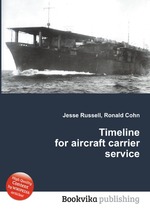Timeline for aircraft carrier service
Jesse Russell Ronald Cohn
бумажная книга
High Quality Content by WIKIPEDIA articles! Aircraft carriers have their origins during the days of World War I. The earliest experiments constisted of fitting temporary "flying off" platforms to the gun turrets of the warships of several nations, notably the United States and the United Kingdom. The first ship to be modified with a permanent flight deck was the light cruiser HMS Furious which initially had a single flying off deck forward of the original superstructure. Subsequently she was modified with a separate "landing on" deck aft and later with a full flush deck. Other ships, often liners, were modified to have full flush flight decks, HMS Argus being the first to have such modification begun. Those first faltering steps gave little indication of just how important the aircraft carrier was to prove to be. During the inter-war years (between the World Wars), Japan, the United Kingdom and the United States built up significant carrier fleets so that by the beginning of World War II, they had 18 carriers between them. The 1940 Battle of Taranto and the 1941 Attack on Pearl Harbor in retrospect showed the world that the aircraft carrier was to be the most important ship in the modern fleet. Today, aircraft carriers are the capital ships of the navies they serve in, and in the case of modern US "supercarriers", they embark an airgroup that is effectively a small air force.


